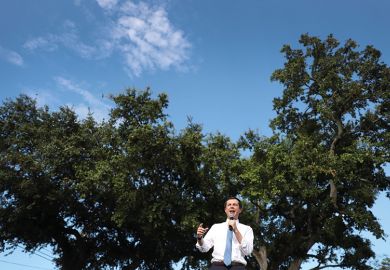Hearing politicians mischaracterise and discredit faculty work is par for the course in academe. It’s much more surprising to hear someone with actual teaching experience do it. So professors shared a collective “WTF?” moment last week when Joseph Epstein, writer and emeritus lecturer in English at Northwestern University, published an op-ed in The Wall Street Journal stating that it’s not uncommon to make $200,000 (£160,046) a year for “essentially a six-month job, and without ever having to put in an eight-hour day”.
The premise of Epstein’s article is that “if government is going to pay for college, at least it ought to try to bring down the cost”, and that he knows where to start cutting because he taught for 30 years. He doesn’t just attack faculty work – Epstein also suggests reducing the salaries of university presidents by 90 per cent, curing administrative bloat and slashing athletic coaches’ pay. But “at the tonier universities”, he says, “professors in the humanities and social sciences might teach as few as three or four courses a year, the remainder of their time supposedly devoted to research”.
Quoting an unnamed former colleague, Epstein calls faculty work a “racket”. He himself later calls it a “sweet racket”.
Under proposed free higher education plans, then, Epstein says, “perhaps it would make sense to pay university teachers by the hour, with raises in the wage awarded by seniority. Surely they could not complain.” After all, he continues, “the two most common comments (some would say the two biggest lies) about university teaching are, ‘I learn so much from my students’ and ‘It’s so inspiring, I’d do it for nothing.’ A strict hourly wage for teachers, as free university education may require, would nicely test the validity of that second proposition.”
Among other things, Epstein’s essay ignores the structural shifts that have occurred since he began teaching – most significantly the transition to majority non-tenure-track workforce. This means that many professors don’t make a salary at all, but are paid on per-course basis. (In this sense, he’s closer to his “strict hourly wage” reality than he thinks. But adjuncts say that the $3,000 they often get to teach a course vastly undervalues the actual work they do to plan it, teach it and be available to students taking it while staying current in their fields. And that shift, in turn – along with public funding cuts – has led to a greater overall workload for tenured and tenure-track professors.)
The essay also ignores the fact that the vast majority of even full-time professors don’t teach at “tonier” colleges and universities. And while it’s true that college costs continue to outpace inflation, professors’ salaries have stayed relatively flat. Last year, for example, full-time faculty pay rose by about 2 per cent. But adjusted for 1.9 per cent inflation, it “barely budged”, according to the American Association of University Professors Faculty Compensation Survey. CUPA-HR’s annual survey said essentially the same.
But then there are the facts about how much full-time professors are actually paid, and how much work they do. Epstein says it’s “not uncommon” for professors to make $200,000 a year, but a more accurate statement would be that it’s not uncommon for professors to make that much at private, independent doctoral institutions. On those research-intensive campuses, the average salary for full professors (not assistant or associate professors) last year was $196,000, according to the AAUP. Associate professors on such campuses made $119,000 on average. Assistant professors made $105,000.
At public doctoral institutions last year, the average full professor salary was $141,000. Associates made about $97,000. Assistants made $84,000. Full-time instructors made about $63,000, while lecturers made about $57,000.
At master’s degree-granting campuses, across institution types, full professors were paid, on average, about $104,000 last year. Across ranks, the average full-time faculty salary at master’s institutions was $81,000. The numbers are nearly the same for baccalaureate degree-granting institutions, and they’re less at associate’s degree-granting campuses. Inside Higher Ed exclusively holds the AAUP’s searchable survey data here.
How much do academics actually work? It varies. And it’s fair to say that academic life entails more flexibility than some other fields. But 50 to 60 hours a week is a good estimate. A small research project at Boise State University in 2014, in which faculty participants tracked their hours, for example, found that professors work 61 hours per week – more than 50 per cent over the traditional 40-hour workweek. About 35 per cent of Monday-to-Friday work was spent on teaching, including grading and preparation. Three per cent of the workweek day was spent on primary research and 2 per cent on manuscript writing.
Professors in that study worked 10 hours a day Monday to Friday and about that much on Saturday and Sunday combined. Just because professors aren’t “at work” doesn’t mean they’re not working. But one finding of that Boise State study is that professors do spend a lot of time in meetings: 17 per cent. Much time was spent on email and other administrative-type tasks.
John Ziker, chair of anthropology at Boise State and a researcher on the faculty workload project, said Epstein’s op-ed was “crazy”, citing median full-professor salary figures of about $100,000 at doctoral institutions with high research activity (as opposed to the highest “very high” research activity).
Esther Morgan-Ellis, an associate professor of music history and world music who serves as the orchestra director and a scholarship and audition coordinator at the University of North Georgia, said she’s “very happy” with her institution, where she enjoys unwavering support in all that she pursues from colleagues and her administration. But Epstein’s essay, she said, “really pissed me off”.
To start, Morgan-Ellis is a tenured associate professor who has worked at her institution for six years. And she just signed a contract for about $60,000. She’s currently working on a passion project, in the form of a university system grant-funded textbook. She plans on putting in 50 more hours. But even if she didn’t do any more work on the book, she’d average about $6.80 per hour on it (she does not get faculty pay cheques over the summer).
Adrianna Kezar, a professor of higher education at the University of Southern California who studies the faculty, said Epstein’s essay “is almost absurd in its lack of accuracy”, starting with the lack of actual full-time salary data. And “the idea of getting paid hourly just to get a fair wage definitely resonates with adjunct positions”, she said. “They honestly would be paid better if they got an hourly wage rather than a lump sum of $3,000 on average to teach an entire class.”
Other studies of faculty productivity and work hours point to an average of closer to 50 hours per week, with some institution types showing even more, Kezar added.
Does history account for Epstein’s lack of accuracy here? Kezar said that hours were “slightly less 40 years ago, but never under 40 hours a week”.
Overall, Kezar said, the “myth that faculty somehow are making a lot of money is very problematic. I think the idea is that other professionals, like doctors and lawyers, make a lot of money so there’s an assumption that professors must as well. Whatever the source, the facts are clearly there to say the contrary.”
Hans-Joerg Tiede, a senior programme officer at the AAUP who has written about its history, said that “there may well have been a time when the overall economic condition of the faculty was better than it is today”. Certainly, he said, “there was a time when the tenure system functioned better than it does today”. But “I think working conditions and salaries have always featured wide differences between institutional types”.
The main reason that “myths about faculty workload persist is that news outlets like The Wall Street Journal perpetuate them”, Tiede said. “It’s certainly well documented that the sort of circumstances that the author describes are not anywhere near the norm.”
Epstein declined to comment on these and other critiques, saying, “I’ve already had my say.”
This is an edited version of an article that originally appeared on Inside Higher Ed.
Register to continue
Why register?
- Registration is free and only takes a moment
- Once registered, you can read 3 articles a month
- Sign up for our newsletter
Subscribe
Or subscribe for unlimited access to:
- Unlimited access to news, views, insights & reviews
- Digital editions
- Digital access to THE’s university and college rankings analysis
Already registered or a current subscriber?




